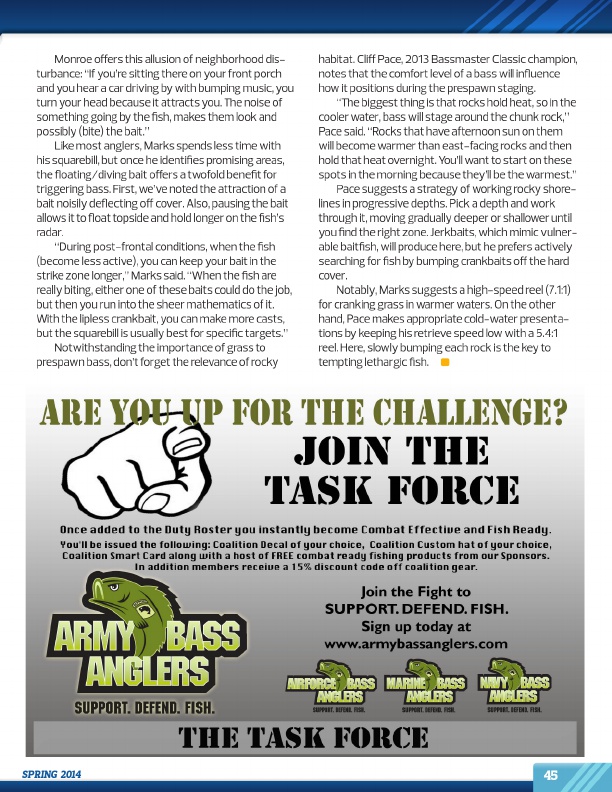
Monroe offers this allusion of neighborhood dis- turbance: “If you’re sitting there on your front porch and you hear a car driving by with bumping music, you turn your head because it attracts you. The noise of something going by the fish, makes them look and possibly (bite) the bait.”
Like most anglers, Marks spends less time with his squarebill, but once he identifies promising areas, the floating/diving bait offers a twofold benefit for triggering bass. First, we’ve noted the attraction of a bait noisily deflecting off cover. Also, pausing the bait allows it to float topside and hold longer on the fish’s radar.
“During post-frontal conditions, when the fish (become less active), you can keep your bait in the strike zone longer,” Marks said. “When the fish are really biting, either one of these baits could do the job, but then you run into the sheer mathematics of it. With the lipless crankbait, you can make more casts, but the squarebill is usually best for specific targets.”
Notwithstanding the importance of grass to prespawn bass, don’t forget the relevance of rocky
habitat. Cliff Pace, 2013 Bassmaster Classic champion, notes that the comfort level of a bass will influence how it positions during the prespawn staging.
“The biggest thing is that rocks hold heat, so in the cooler water, bass will stage around the chunk rock,” Pace said. “Rocks that have afternoon sun on them will become warmer than east-facing rocks and then hold that heat overnight. You’ll want to start on these spots in the morning because they’ll be the warmest.”
Pace suggests a strategy of working rocky shore- lines in progressive depths. Pick a depth and work through it, moving gradually deeper or shallower until you find the right zone. Jerkbaits, which mimic vulner- able baitfish, will produce here, but he prefers actively searching for fish by bumping crankbaits off the hard cover.
Notably, Marks suggests a high-speed reel (7.1:1) for cranking grass in warmer waters. On the other hand, Pace makes appropriate cold-water presenta- tions by keeping his retrieve speed low with a 5.4:1 reel. Here, slowly bumping each rock is the key to tempting lethargic fish.
SPRING 2014
45
http://www.armybassanglers.com/